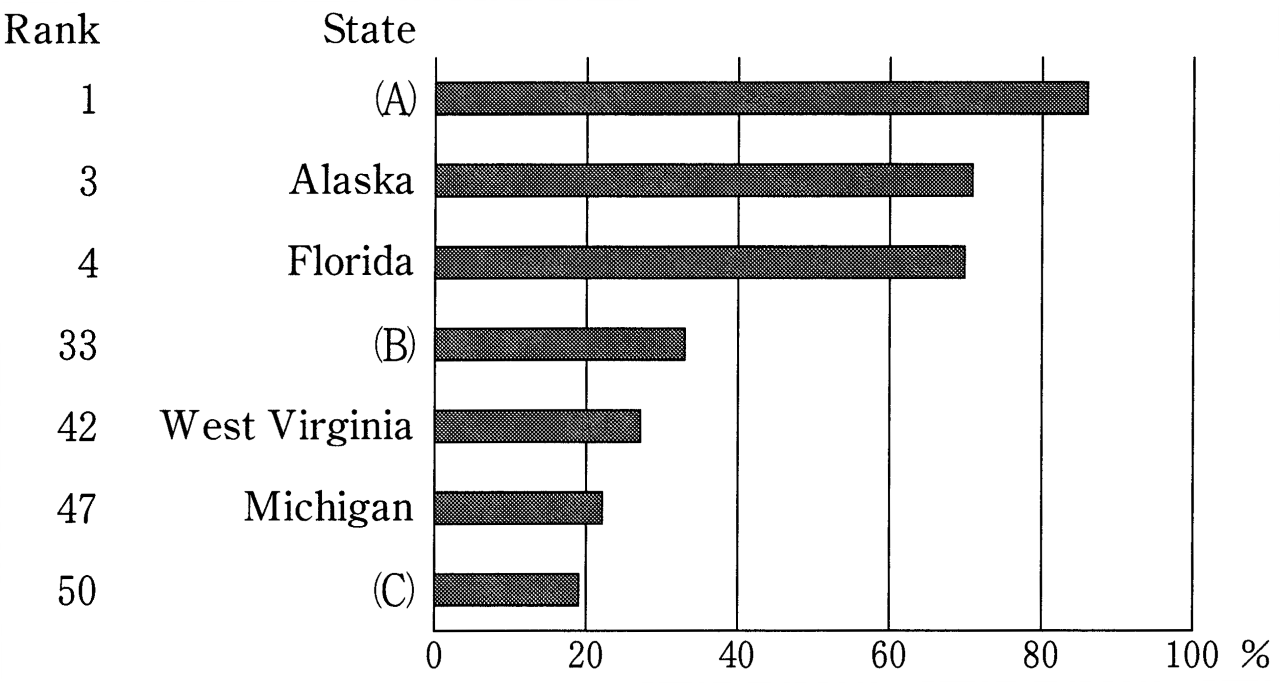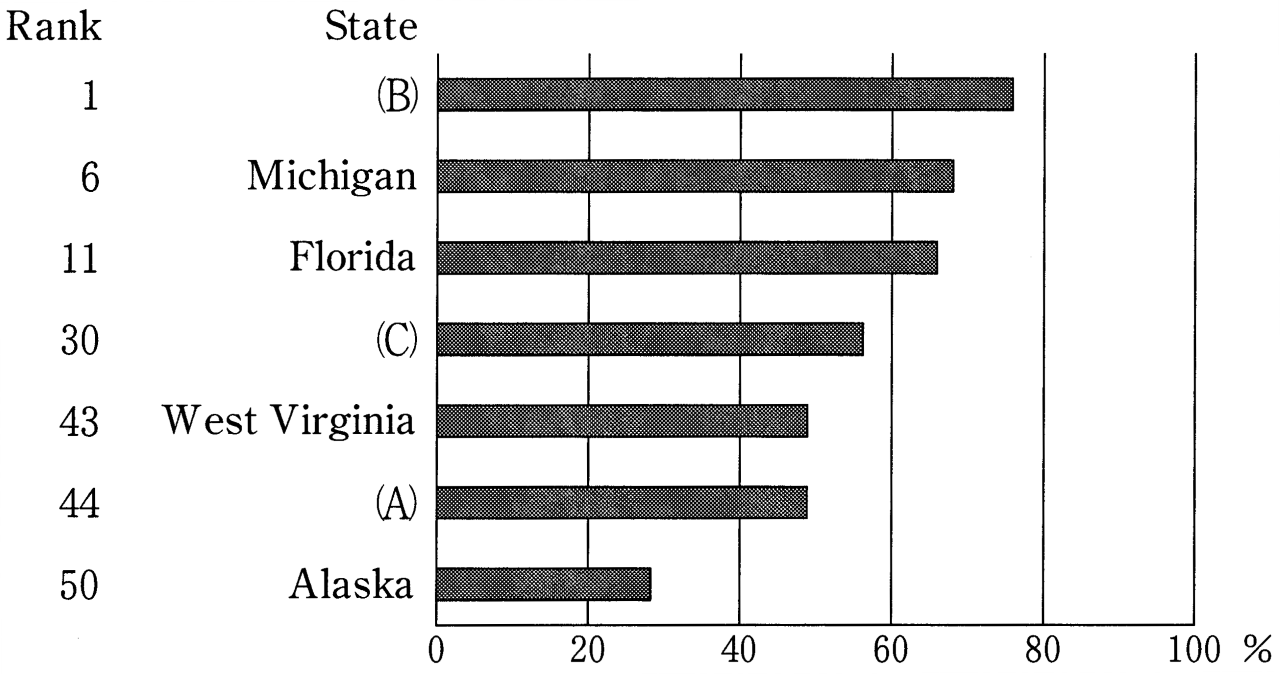English reading for Japanese high school students: the Common Test for University Admissions in 2014 DAY 1
Part 4A
The following text is part of a report. Read the text and the graph, and choose one of the following (1) to (4), respectively, that is most appropriate to put in [35] to [38] of the following questions (Question 1 to 4).
Magnet and Sticky: A Study on State-to-State Migration in the US
Some people live their whole lives near their places of birth, while others move elsewhere. A study conducted by the Pew Research Center looked into the state-to-state moving patterns of Americans. The study examined each state to determine how many of their adult citizens have moved there from other states. States with high percentages of these residents are called “magnet” states in the report. The study also investigated what percent of adults born in each state are still living there. States high in these numbers are called “sticky” states. The study found that some states were both magnet and sticky, while others were neither. There were also states that were only magnet or only sticky.
Figures 1 and 2 show how selected states rank on magnet and sticky scales, respectively. Florida is a good example of a state that ranks high on both. Seventy percent of its current adult population was born in another state; at the same time, 66% of adults born in Florida are still living there. On the other hand, West Virginia is neither magnet (only 27%) nor particularly sticky (49%). In other words, it has few newcomers, and relatively few West Virginians stay there. Michigan is a typical example of a state which is highly sticky, but very low magnet. In contrast, Alaska, which ranks near the top of the magnet scale, is the least sticky of all states.
Three other extreme examples also appear in Figures 1 and 2. The first is Nevada, where the high proportion of adult residents born out of state makes this state America’s top magnet. New York is at the opposite end of the magnet scale, even though it is attractive to immigrants from other nations. The third extreme example is Texas, at the opposite end of the sticky scale from Alaska. Although it is a fairly weak magnet, Texas is the nation’s stickiest state.

Figure 1. Magnet scale (selected states).

Figure 2. Sticky scale (selected states).
The study went on to explore the reasons why “movers” leave their home states and “stayers” remain. As for movers, there is no single factor that influences their decisions to move to other states. The most common reason they gave for moving is to seek job or business opportunities. Others report moving for personal reasons: family ties, the desire to live in a good community for their children, or retirement.
(References: Pew Research Center (2008) American Mobility)
Question 1 If a state is magnet, [35].
(1) few adults born there have stayed
(2) few adults living there were born elsewhere
(3) many adults born there have stayed
(4) many adults living there were born elsewhere
Question 2 Which three states are represented in Figures 1 and 2 as (A), (B), and (C)? [36]
(1) (A) Nevada (B) New York (C) Texas
(2) (A) Nevada (B) Texas (C) New York
(3) (A) New York (B) Nevada (C) Texas
(4) (A) New York (B) Texas (C) Nevada
Question 3 The main purpose of this passage is to [37].
(1) describe various patterns in American migration
(2) explain why some states are less popular than others
(3) list states with a high ratio of adults who were born there
(4) report how the Pew Research Center collected data
Question 4 What topic might follow the last paragraph? [38]
(1) Reasons why some Americans stay in their home states.
(2) States that attract immigrants from other countries.
(3) Types of occupations movers look for in other states.
(4) Ways to raise children in a magnet state community.
Answer
Question 1 [35] (4)
Question 2 [36] (2)
Question 3 [37] (1)
Question 4 [38] (1)
Part 4B
Read the website about marathon registration on the following page, and choose one of the following (1) to (4) as the most appropriate answer for questions [39] to [41] of the following questions (Question 1 to Question 3).
Question 1: Which of the following statements is NOT true about applying? [39]
(1) You must apply during the month of August.
(2) You must be at least 16 years old when you apply.
(3) You must enter your application via the Internet.
(4) You must submit no more than one application.
Question 2: A 70-year-old woman living in Lakeville who competed in the 26th marathon will have to pay [40] to participate.
(1) $10
(2) $15
(3) $25
(4) $30
Question 3: According to the website, which of the following is true? [41]
(1) You can pay the application and entry fees in cash.
(2) You have to make all inquiries by phone.
(3) You must check online to see if you are accepted.
(4) You will have eight hours to finish the race.
The 28th LAKEVILLE MARATHON
February 26, 2015
APPLICATION
> Period: August 1 – August 31, 2014 (NO late applications will be accepted.)
Anyone 16 or older on the day of the race may apply for entry.
> Online applications only.
> One application per person. Multiple applications will be automatically rejected.
> Reporting any false personal information will result in elimination.
SELECTION
> Unfortunately, due to the size of Lakeville Sports Field, not all applications can be accepted. The 15,000 runners will be determined by lottery.
> Applicants will receive their acceptance or rejection letter in mid-October.
PAYMENT
> Online credit card payments only.
> The application fee cannot be returned. NO exceptions.
> The entry fee will be charged only to those selected by lottery.
| Category | Application fee** | Entry fee** | |
| Minor(16 or 17) | $15 | $25 | |
| Adult(18 to 64) | $15 | $50 | |
| Senior(65 or over) | $15 | $15 |
*No application fee if you live in Lakeville!
**$5 discount if you entered either of the last two Lakeville Marathons!
RACE DAY
> Check-in: Opens at 7:00. All participants must present a photo ID (for example, driver’s license or passport) and their acceptance letter on the day of the race.
> Race schedule: Starts at 8:00/Finishes at 16:00 (Runners who fail to finish by the designated time must stop running.)
For inquiries, contact: marathondesk@lkve.com
CLICK HERE TO APPLY
Answer
Question 1 [39] (2)
Question 2 [40] (1)
Question 3 [41] (4)
SNSでシェア